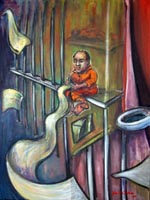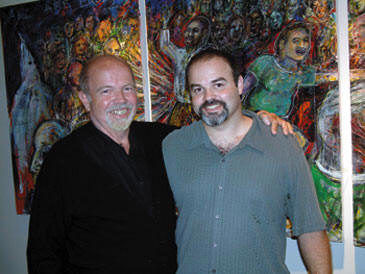Artist's brush brings
court cases to canvas
Lawyer
Xavier Cortada creates an exhibit
specifically for the Supreme Court
By Jan Pudlow
Associate Editor
Published March 15, 2004 in The Florida Bar News
Xavier
Cortada calls his solo exhibit of spirited paintings, “May It Please the Court.”
“And I hope it does,” added this gregarious
Cuban-American from Miami, who does pro bono work on children’s issues as
a lawyer but makes his living splashing bold colors on canvas with a
social activist’s zeal.
Mission accomplished.
Plenty of praise poured from several justices
during the March 1 opening reception at the Florida Supreme Court, as they
gazed at dramatic depictions of six well-known Florida cases that sprang
to life with potent symbolism.
“I am just amazed by the power of some of
these paintings,” said Justice Barbara Pariente. “And I am just
overwhelmed that Xavier would have created these paintings just for this
exhibit.”
Evidence of the artist’s frantic deadline for
the exhibit’s opening day was the still-wet oil on the painting “The
Miami Herald Publishing Co. v. Tornillo,”
accompanied with the words “Extra, extra. Read all about it: Freedom of
expression includes freedom of opinion.”
There was plenty of free expression in
39-year-old Cortada’s efforts to capture the meaning of landmark Florida
cases dealing with everything from freedom of religion in “Church
of the Lukumi Babalu Aye v. City of Hialeah”
to states rights in “Seminole Tribe
v. Florida.”
Cortada’s favorite piece created specifically
for this exhibit was suggested by Chief Justice Harry Lee Anstead: “Gideon
v. Wainwright — Because Gideon
decided to write from his cell, others were guaranteed a right to counsel
before being sent to theirs.”
“There are a million ways I could have
described Gideon,”
Cortada said, standing before the 4-foot-by-3-foot oil on canvas with
passionate gestures at the small figure of Gideon, dwarfed by the cold
steel bars of his cell, writing on a long roll of toilet paper.
 “I read this Robert Kennedy quote about Gideon
taking charge and changing the course of history. Gideon could have
literally done what his cell mate is doing, just sitting back and rotting
away in jail. He could have used that paper as toilet paper. Instead, what
Gideon decided to do is act,” Cortada explained.
“I read this Robert Kennedy quote about Gideon
taking charge and changing the course of history. Gideon could have
literally done what his cell mate is doing, just sitting back and rotting
away in jail. He could have used that paper as toilet paper. Instead, what
Gideon decided to do is act,” Cortada explained.
“Even in the most isolated, remote place, he
said, ‘I am going to challenge.’ For someone who is marginalized to that
level: You’re sitting in jail; you’re a homeless guy, a roamer, a drifter,
no money, no nothing, no power. And you can single-handedly, on toilet
paper (even though I’m taking creative license. I’m sure it was real
paper) change the course of history. I think it speaks volumes for what we
as a society can do. And that’s what I am trying to do through this
exhibit.”
Cortada is known around the world for using
his art as advocacy for social issues, commissioned to create murals for
The White House, The World Bank, Global Health Council, and the
International AIDS Conferences (XII & XIII).
“I care passionately about the law,” said
Cortada, a 1992 University of Miami School of Law graduate. “Going to law
school informed
my career as an artist, which is why I paint
these things instead of landscapes and flowers. I use art as a tool for
advocacy.”
That is strikingly apparent in his
acrylic-on-canvas triptych titled, “All are equal (1), but some are more
equal than others (2),” created in 2002 to commemorate the 25th
anniversary of the passage of the Dade County Human Rights Ordinance by
the Dade County Commission.
“The point I am trying to make is that when
there is one insular minority, when there is one group of citizens
targeted or in any way diminished, all of us as human beings are
diminished. And our society becomes less free. When our society is less
free, every single one of us is less free,” Cortada said.
“This piece is timely, and it is about me. As
an openly gay man, I am really concerned about what our society is doing,
particularly today, and how easy it is to marginalize people. It is done
to gays today, as it was done to African-Americans. . . . It is the civil
rights issue of our time. So it is important to me for this piece to be
here. Hopefully, it will open some minds.”
He stood before that mural with his Cuban-born
father, Carlos Cortada, who fled to Miami 42 years ago. “I am proud of my
son, and I think I have very good reason to be,” Carlos Cortada said. “I
am a painter, too.”
He recalled how he would paint at night, and
his young son would dabble with the paints, too, and say, “Dad, take a
little longer.” The father would admonish, “You have to go to sleep now!”
And the boy would beg: “Just a little longer!”
That childhood passion for painting came in
handy when Xavier Cortada was in Soweto, South Africa, five months after
apartheid was lifted. He was a faculty member sent by the State Department
to teach homeless children.
“The kids couldn’t communicate with me, and I
couldn’t communicate with them. I was wearing a tie, because I was very
professional. Who am I? So I started doing what my father taught me, which
is sketching and drawing. And that’s what they did. Before you knew it,
there was this powerful communication going on back and forth. And I
realized, oh my God!, what a powerful, powerful language. And if you look
at the two paintings downstairs, of kids in adult prison and in the
psychiatric hospital (“Convictim,” and “The Voice Project 2003 Mural” with
youth at the Jackson Memorial Hospital SIPP residential program), it’s
that same thread. I used art as a vehicle to have these kids open up and
express themselves in ways that they would not otherwise.”
It was Justice Raoul Cantero who nominated the
work of Cortada for this latest Arts in the Court exhibit that invites the
public to step inside the marbled high court and climb the stairs to the
rotunda-turned-gallery.
“I am very proud to have the opportunity to
have Xavier, who clerked for me, and also a Cuban-American from Miami
displaying his paintings here,” Justice Cantero said.
Justice Peggy Quince, studying the symbolism
in the paintings with legal intern Paul Ghiotto, exclaimed: “I love having
art in the court. This is an especially good exhibit, because it’s about
the legal profession. Many of these are about cases that were actually
decided here.”
Tallahassee lawyer Katrice Jenkins said she
was particularly struck by “Proffitt
v Florida,” an important Florida
death penalty case. The accompanying words said: “Capital punishment
formula: 7M + 8A= 0 (CU); M=mitigating, A=aggravating, CU=cruel and
unusual.”
“It really brings the cases to life,” she
said. “Proffitt,
for instance, that was a really great one, the depiction of mitigating and
aggravating factors. Overall, I think this is magnificent. Yes, it is
truly amazing. It really does bring all of the things you’ve read about —yeow!
—right in your face!”
As Cortada explained that painting: “It has
Francis Bacon written all over it. He has a piece about a pope sitting in
a chair and it looks very electric. It’s almost ridiculous: 7 mitigating +
8 aggravating = CU. That’s how we create a formula. It’s the same way with
kids in adult prison. You can almost absolve whatever irrationality by
using formulas,” he said, adding the formula de-emotionalizes the death
penalty so that it can be carried out.
“To me, it is a fantastic painting. There is
nothing more fantastic than the death penalty. If it’s shocking, and if
it’s loud, and if it’s brash, then it needs to be here. Because what
happens in this room is loud and brash, and it needs to be addressed.”
The last time Cortada was at the Supreme
Court, he said, he only had 60 seconds to address the justices in oral
argument.
“Now I have more time to articulate with the
justices in a way that is more lasting. Using art, I allow the audience to
draw their own conclusions, instead of me to advocate my point of view. As
an attorney, to have my art at the Supreme Court is a particularly huge
honor.”
“May it Please the Court” exhibit at the
Florida Supreme Court runs through July 15. To commemorate Law Day, four
additional pieces will be brought to Tallahassee by May 1, including “Bush
v. Gore.” For
more information, visit
www.cortada.com.

Xavier Cortada, right, with his father,
Carlos Cortada.